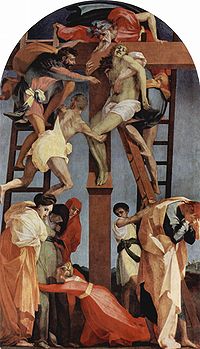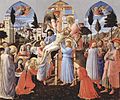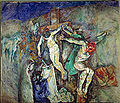- Descent from the Cross
-
The Descent from the Cross (Greek: Ἀποκαθήλωσις, Apokathelosis), or Deposition of Christ, is the scene, as depicted in art, from the Gospels' accounts of Joseph of Arimathea and Nicodemus taking Christ down from the cross after his crucifixion (John 19:38-42). In Byzantine art the topic became popular in the 9th century, and in the West from the 10th century. The Descent from the Cross is the 13th Station of the Cross.
Other figures not mentioned in the Gospels who are often included in depictions of this subject include St. John the Evangelist, who is sometimes depicted supporting a fainting Mary (as in the work below by Rogier van der Weyden), and Mary Magdalene. The Gospels mention an undefined number of women as watching the crucifixion, including the Three Marys, (Mary Salome being mentioned in Mark 15:40), and also that the Virgin Mary and Mary Magdalene saw the burial (Mark 15:47). These and further women and unnamed male helpers are often shown.[1]
Contents
Development of the image
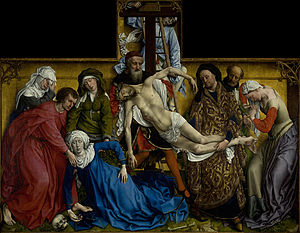 Rogier van der Weyden. The Descent from the Cross. (c.1435) Oil on oak panel, 220 x 262 cm Museo del Prado, Madrid
Rogier van der Weyden. The Descent from the Cross. (c.1435) Oil on oak panel, 220 x 262 cm Museo del Prado, Madrid
Even in early depictions the details and posing of the composition, and especially the position of Christ's body, are varied. The scene was usually included in medieval cycles of the Life or the Passion of Christ, between the Crucifixion and the Entombment of Christ. The Lamentation of Christ, or Pietà, showing the body of Christ held by Mary, may intervene between these two, and is common as an individual image, especially in sculpture. The Bearing of the body, showing Christ's body being carried to his tomb, and the Anointing of Christ's body, showing the body laid flat on the top of the tomb or a similarly-shaped "anointing-stone" are other scenes that may be shown. This last is especially important in Orthodox art, where it is shown on the Epitaphios.
With the Renaissance the subject became popular for altarpieces, partly because of the challenges of the composition, and the suitability of its vertical shape. The Mannerist version of Rosso Fiorentino is usually regarded as his most important work, and Pontormo's altarpiece is perhaps his most ambitious work. The subject was painted several times by both Rubens and Rembrandt, who repeated one of his paintings (now in Munich) in a large print, his only one to be mainly engraved, as well as making two other etchings of the subject.
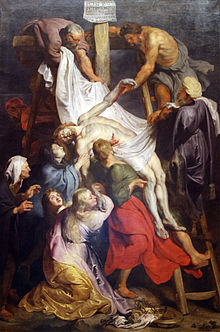 Deposition by Rubens, (Lille).
Deposition by Rubens, (Lille).
Selected examples
- Codex Grecus 510 (9th century Byzantine, Bibliothèque nationale, Paris)
- Codex Egberti (ca. 980, Trier city library).
- St Albans Psalter - English Romanesque miniature (ca. 1130-45) [1]
- Externsteine relief (12th century)
- Toros Roslin (13th century) [2]
- Byzantine Museum of Kastoria (ca. 1400) [3]
- Rogier van der Weyden, Descent from the Cross (ca. 1435, Museo del Prado, Madrid)
- Nicolas Mostaert (1579) [4]
- Rubens (1611–14, Antwerp cathedral) The Descent from the Cross
- Rembrandt (1634, Hermitage Museum, Saint Petersburg) [5] [6] [7]
- Athens, Benaki Museum No. 3001 (ca. 1700) [8]
- Gustave Doré [9]
- Max Beckmann (1917) [10]
- Enrique Miguel de la Vega [11]
- The Deposition from the Cross (1528) by Jacopo Pontormo at the Capponi Chapel in the church of Santa Felicita, in Florence.
- Fra Angelico, Deposition of Christ, executed between 1432 and 1434, now in the National Museum of San Marco, Florence.
- Caravaggio, The Entombment of Christ (1602–1603), now at the Vatican Pinacoteca.
- Eastern Orthodox Icons of the Descent from the Cross.[12]
- The Epitaphios used during Holy Week[13]
- The Antimension [14]
Gallery
-
Benedetto Antelami.
Deposition from the Cross (1178). Carved stone relief.
Parma Cathedral -
Externsteine Relief (12th century). Natural sandstone.
Teutoburger Wald, Germany -
Limbourg brothers.
The Deposition, Les Très Riches Heures du duc de Berry, Folio 156v (c. 1410). Illuminated manuscript.
Musée Condé, Chantilly -
Fra Angelico.
Deposition of Christ, Fra Angelico (1437-1440). Tempera on wood, 176 x 185 cm.
Museo di San Marco, Florence -
Anonymous.
Deposition of the Cross
Church of Our Lady, Bruges, Belgium -
The prayer Obsecro te (1470s), from the Book of Hours of Angers
Bodleian Library, University of Oxford -
Descent from the Cross (1495), from Ss. Johns' church in Toruń.
Diocesan Museum, Pelplin -
Pietro Perugino.
Deposition (1495)
Galleria dell'Accademia, Florence -
Guglielmo della Porta.
Deposition (16th century). Marble.
Museo d'arte antica, Castello Sforzesco, Milan -
Rosso Fiorentino.
Deposition (1521). Oil on wood, 375 × 196 cm.
Pinacoteca Comunale di Volterra -
Jacopo Pontormo.
The Deposition from the Cross (1528). Oil on wood, 313 × 192 cm.
Santa Felicità, Florence -
Agnolo di Cosimo ("Bronzino")
Deposition of Christ (1540-1545) Oil on wood, 268 × 173 cm
Musée des Beaux-Arts, Besançon -
Caravaggio.
The Entombment of Christ (1604).
Pinacoteca Vaticana, Rome -
Simone Peterzano, Deposition of Christ, church of San Fedele, Milan
-
Peter Paul Rubens.
The Descent from the Cross (c. 1612). Oil on wood 420.5 × 320 cm
Cathedral of Our Lady, Antwerp -
Jean Jouvenet, The Descent from the Cross (1697).
Musée du Louvre, Paris -
The Deposition from the Cross (18th century). Clay statues.
Sacro Monte di Belmonte (near Turin) -
Jean-Baptiste Regnault.
Deposition (c. 1789). Oil on panel
Stanford Museum, Stanford University, California -
Deposition. Carved and painted stone.
Church of Santa Teresinha, Porto Alegre, Brazil -
Cluny Abbey
Deposition with Twelve Apostles (bishop's mitre). Ink on cloth
Musée national du Moyen, Paris -
Antonio Ciseri.
The Deposition of Christ (c. 1883) -
Antimension (1890). Printed on silk.
Oradea-Mare, Transylvania, Romania -
Viktor Vasnetsov
Entombment, (1896). Mural.
St Volodymyr's Cathedral, Kiev -
Jacek Andrzej Rossakiewicz.
The Deposition (St John Passion - 7) (1990). Oil on canvas, 245 x 140 cm -
Titian, 1559
See also
- Antimension
- Entombment of Christ
- Epitaphios
- Pietà
- Seven Sorrows of Mary
References
- ^ G. Schiller, Iconography of Christian Art, Vol. II, 1972 (English trans from German), Lund Humphries, London, p.164, ISBN 853313245
External links
- Eastern depictions from The Grove Dictionary of Art
Categories:- Byzantine art
- Christian iconography
- Gospel episodes
- Iconography of Jesus
- Stations of the Cross
- Art of the Passion
Wikimedia Foundation. 2010.

